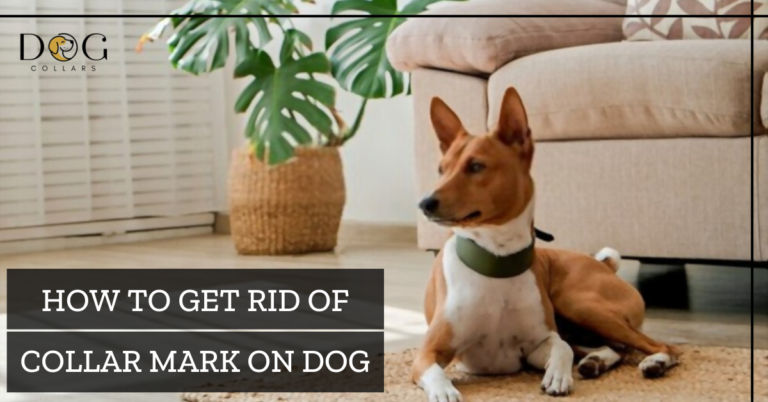Can You Bathe a Dog with Flea Collar On – Safety and Tips

Bathing my dog with his flea collar on? Absolutely! Because let’s face it, we’re not just fighting against dirt, we’re fighting against pests, too.
Yes, you can technically bathe a dog with a flea collar on. However, this is not the best practice. Proper hygiene and flea prevention are crucial for your dog’s health, and removing the collar before bathing ensures its effectiveness is not compromised. It is advisable to put the collar back on once your dog is fully dry after the bath.
Just because we’re washing off the dirt doesn’t mean we’re washing off protection. Here we will learn can you bathe a dog with flea collar on, But there is a need to discuss some concerns about it. Let’s explore!
Addressing Concerns: Bathing Your Dog While Wearing a Flea Collar
When it comes to washing your dog while wearing a flea collar, there can be some concerns. Some pet owners worry that the water and soap will remove the active ingredient from the collar, rendering it ineffective. Others may be concerned about potential skin irritation or harm to their dog’s health.
- However, rest assured that it is safe and effective to wash your dog with a flea collar on as long as you follow some simple steps. First, make sure you use a mild shampoo specifically designed for dogs rather than human shampoo which can irritate their skin.
- Secondly, avoid using hot water during bath time because high temperatures can damage the pest collar’s effectiveness. It’s best to stick with lukewarm water instead.
- If your furry friend has an existing skin condition or sensitivity issues around the neck area where the insect band sits, consult with your veterinarian first before giving them a bath with their bug collar on.
By following these precautions and guidelines, you should feel confident in safely grooming your dog while also ensuring they stay protected against fleas and ticks!
A Step-By-Step Guide to Bathing a Dog With a Pest Collar
Bathing your dog with a flea collar on requires some extra care and attention to ensure that the collar remains effective in repelling fleas and ticks. Here’s a step-by-step guide to giving your furry friend a bath while wearing their protection neckband:
1. Brush your dog’s fur thoroughly before their bath to remove any loose hair, dirt, or debris.
2. Fill up the bathtub or sink with warm water (not too hot!) and wet your dog’s coat completely.
3. Apply a small amount of flea shampoo specifically formulated for dogs onto your palms and lather it up on their coat, avoiding contact with their eyes.
4. Gently massage the shampoo into all areas of your dog’s body – including underbelly, paws, tail, neck, etc.– ensuring you reach deep down to the skin where fleas may be hiding.
5. Rinse off all traces of shampoo from their coat using clean water until there are no bubbles left behind.
6. Towel dry them thoroughly so they don’t get cold after bathing; if weather permits then let them air dry naturally outside in sunlight
Remember not to use human shampoos as these can damage both skin and hair! By following these steps carefully you’ll effectively wash away any lingering fleas without compromising the effectiveness of the bug collar in keeping future infestations at bay!
Monitoring Your Dog Post-Bath
After showering your dog with a flea collar on, it’s important to monitor them for any signs of discomfort or irritation. A few things you can do to ensure they’re feeling good post-bath include:
- Firstly, dry them off as best you can with towels, and then let them shake themselves out. This will help remove excess water from their fur and prevent skin irritation.
- Next, make sure the room is warm so they don’t get cold after the bath. You might want to use a blow dryer on low heat if your dog has long hair and takes longer to dry.
- Once they’re completely dry, inspect their coat for any signs of fleas or ticks that may not have been removed during the bath. Use a flea comb to carefully check around their neck and ears where fleas tend to hide.
- Watch out for any unusual behavior like scratching or biting at specific areas of their body which could indicate that there are still some fleas present.
By monitoring your dog closely after giving them a bath with a pest neckband on, you can be confident that they’re safe from a further infestation and comfortable in their own skin!
Can I Bathe My Dog With the Seresto Collar On, Without Decreasing Effectiveness?
Many pet owners are concerned about whether or not they can shower their dogs while wearing a flea band. The Seresto dog collar is known for its ability to effectively repel and kill fleas, ticks, and other pests for up to 8 months. However, when it comes time to give your pup a bath, you may be wondering if the collar will still work as intended.
The good news is that the Seresto collar is designed to withstand water exposure without losing effectiveness. This means that you can safely shower your dog with the collar on and not have to worry about decreasing its efficacy in preventing flea infestations.
It’s important to note that while grooming your dog with the Seresto collar on won’t harm its effectiveness, it’s always recommended to follow proper washing techniques. Avoid using harsh chemicals or high-pressure water streams as this could potentially damage both the collar and your dog’s skin.
There’s no need to remove the Seresto pest band before giving your furry friend a bath. You can rest assured knowing that it will continue working just as well after being exposed to water.
Why Bathe Your Dog?
It is an essential part of their overall health and well-being. Just like humans, dogs can get dirty, oily, and smelly over time. Showering your dog regularly helps to remove dirt, debris, bacteria, and allergens from their skin and coat.
Regular baths also help to prevent flea infestations by removing any adult fleas or eggs that may be present on your pet’s body. Not only that but this can also help soothe irritated skin caused by allergies or other skin conditions.
Furthermore, some breeds require more frequent washing than others due to their unique coat types or lifestyles. For example, dogs who spend a lot of time outdoors may need more frequent baths to remove dirt and grime from their fur.
Regular bathing is an important aspect of keeping your furry friend healthy and happy. Make sure to use a gentle detergent specifically designed for dogs and avoid using harsh soaps or human cleansers which can irritate their sensitive skin.
Should You Consult a Veterinarian?
If you are unsure about showering a pet with a bug neckband on, it is always best to consult your vet. Your vet can advise you on the appropriate steps to take and recommend suitable products for your dog’s specific needs.
Veterinarians have extensive knowledge of flea infestations and understand the active ingredients in various products. They can help identify if a particular product is safe for use during bath time or whether it may cause adverse reactions in your pet.
In some cases, dogs may suffer from allergic reactions or other health issues that make them more sensitive to certain flea treatments. A veterinarian can offer advice on alternative treatments or suggest ways to minimize any risks associated with using tick collars while bathing your pet.
Additionally, some breeds of dogs may require special care when being washed, such as those with sensitive skin or long hair. Consulting a veterinarian ensures that you get tailored advice based on your dog’s individual needs.
Consulting a vet before grooming your pet with a pest band is always recommended for optimal results and peace of mind.
Conclusion
Bathing your dog with a flea and tick collar on can be done safely and effectively if you follow the proper steps. Make sure to monitor your dog after the bath for any signs of skin irritation or discomfort. Always consult with your vet before using any new flea treatment products or methods. Regularly checking and removing fleas from your dog’s skin and hair is crucial in preventing a flea infestation and keeping your furry friend healthy and happy.
Remember to use topical flea treatments, sprays, shampoos, or collars that contain active ingredients that kill both adult fleas and larvae to help combat the problem at its source. With these tips in mind, you’ll be able to keep your pet free from pesky fleas!
FAQs:
Can a dog flea collar get wet?
Yes, dog flea collars are designed to be water-resistant or waterproof. They can withstand exposure to water, such as rain or occasional splashes, without losing their effectiveness.
What are fleas and why are they a problem?
Fleas are small parasitic insects that feed on the blood of animals, including dogs, cats, and humans. They are a problem because their bites can cause itching, discomfort, and skin irritation. Fleas can also transmit diseases and parasites, such as tapeworms, to their hosts.
What is a flea collar and how does it work?
When placed around the neck of a pet, the collar releases these substances, which spread across the pet’s fur and skin. The chemicals work by either repelling fleas, making the pet less attractive to them, or killing fleas upon contact.
Do dogs need bathing if they have a flea collar On?
Yes, dogs may still need bathing even if they have a flea neckband on. Bathing helps maintain their overall hygiene and cleanliness.
What type of shampoo should you use?
Look for dog shampoos that are mild, hypoallergenic, and designed for your dog’s specific needs, such as moisturizing cleansers for dry skin or flea and tick soap for pest control.
Can pest collars be used in conjunction with other flea treatment methods?
Yes, pest collars can be used in conjunction with other flea treatment methods. They can be used alongside topical flea treatments, oral medications, or flea shampoos.






